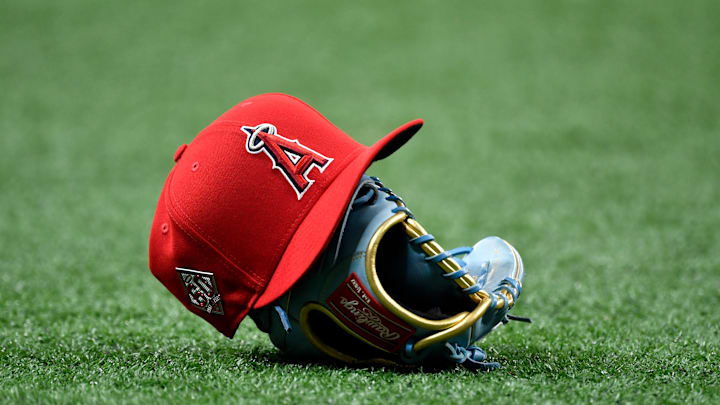
Michael Stefanic has had a meteoric rise through the LA Angels’ minor league system. If you exclude the cancelled 2020 season and his brief 14-game stint in rookie ball back in 2018, the 25-year-old has essentially risen from Low-A to Triple-A in just two seasons.
Even more impressive is the fact that he started out as a nondrafted free agent whom the Angels only signed after receiving one of his homemade prospect videos which he sent to every team. Now that’s what you call determination.
Despite never being recognized as a top prospect, Michael Stefanic has the talent to be an effective second basemen for the Angels.
Though he’s seen over 500 innings at shortstop, Michael Stefanic is most experienced as a second baseman (1111 innings), meaning Fletcher would likely be moved over to short or the bench (if Brendon Davis is called up as well) in this scenario.
Coincidentally, Stefanic is actually pretty similar to Fletcher as a hitter; he’s a high-contact, low-strikeout guy who puts the ball in play no matter what.
In his minor league career, Stefanic is slashing .314/.388/.436 (.824 OPS) with 44 doubles, 130 runs, 115 RBIs, and only 129 strikeouts across 241 games and 1019 plate appearances. One of the elite young hitters in the minors, his .336 BA and .408 OBP last year were second and third best, respectively, among all minor leaguers with at least 500 plate appearances in 2021.
What sets him apart from Fletcher, however, is his newfound power at the plate.
During the cancelled 2020 season, Stefanic took the time to reevaluate his hitting style and found a way to add some more launch angle to the balls he puts in play, without sacrificing his high-contact abilities.
The result was 17 home runs and a career-high .493 SLG% in 125 games last year. Granted, while this increase in home runs was no doubt aided by the fact that Triple-A West is a notoriously hitter friendly league, it doesn’t take away from the fact that his new hitting style is what enabled him to hit more fly balls in the first place.
For what it’s worth, Fangraphs’ 2022 ZiPS projections are somewhat positive on Stefanic’s bat, giving him a projected slash line of .266/.328/.380 (.708 OPS, 93 OPS+). Fletcher, meanwhile, is actually projected to do worse with a .693 OPS (more on that significance later).
As for his other stats, ZiPS is giving Stefanic 12 home runs, 19 doubles and 45 RBIs in 529 plate appearances. Also, remember that these projections are just a baseline, meaning that his actual offensive outlook could be even better than these numbers suggest, especially if his increased launch angle is here to stay.
Sheeessshhhh that's Michael Stefanic's second homer of the night. pic.twitter.com/DTqDltAa2m
— Salt Lake Bees (@SaltLakeBees) August 15, 2021
Unfortunately, things aren't so cut and dry when it comes to Stefanic’s defensive skills. While he’s certainly improved as he’s progressed through the Angels’ farm system, he’s still not the most adept fielder.
In his 1111 innings at second, he owns a .974 fielding percentage, as well as 211 putouts and 319 assists, giving him a slightly above average 4.29 RF/9 (Range Factor per 9 innings) and 4.08 RF/G (Range Factor per game). He did, however, also commit 14 errors in this span.
Looking at just his numbers in Triple-A last season, he does compare quite favorably to the other second basemen in the western division.
On top of leading the west in games played at second (72), he also led the division in putouts (112), was second in assists (173), and third in fielding percentage (.973) and RF/G (3.958) among players with at least 40 games played.
If you want to be somewhat irresponsible and compare Stefanic’s total output from last year to a similar major leaguer, you’ll notice they stack up almost identically with Willi Castro, who was worth an abysmal -8 DRS and -3.5 UZR last season.
- Stefanic: 740 innings, 358 chances, 135 putouts, 214 assists, 9 errors, .975 Fld%, 4.24 RF/9
- Castro: 713.2 innings, 360 chances, 141 putouts, 211 assists, 8 errors, .978 Fld%, 4.44 RF/9
For reference, the league average for second basemen in Fld% last year was .988, while RF/9 was 4.04.
Now, it should go without saying, but these numbers should be taken with a massive grain of salt since minor league fielding metrics are very primitive compared to the majors (hence no DRS, UZR or Statcast data), meaning this isn’t exactly a one-to-one comparison. There simply isn’t enough publicly available hard data for things like positioning, range and reaction time.
That said, looking back at the ZiPS projections, Stefanic does earn a solid 2 in the defense stat, tying him for the third highest total on the team and just one point behind Fletcher.
Overall, there’s no denying Stefanic’s underlying talent at second, where he was a four-time Golden State Athletic Conference Gold Glover back in college. Plus, if his progress up to now is any indicator, getting some time with major league coaches and resources might be just what he needs to take his defense to the next level.
Once again turning to the ZiPS projections, Stefanic has the fifth highest zWAR (the type of WAR used only in these projections) on the team with 1.5. For reference, Fletcher is right behind him with 1.4.
If that’s just a conservative estimate for what Stefanic can do in his rookie season, things are looking up for the young second baseman.
Bottom line, Stefanic looks major league ready right now and should be with the team on opening day.
